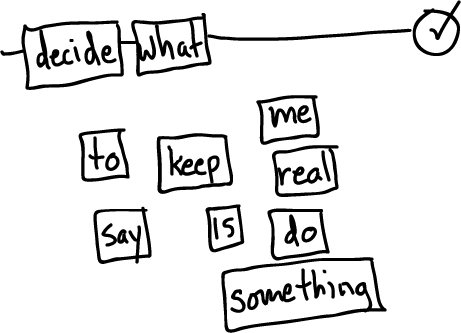Some Background
A few years ago I stumbled upon the amazing advertising for OmegaMart. It produced a sense of the uncanny which I found both funny and intriguing.
I quickly became obsessed and learned all I could about OmegaMart and Meow Wolf, its creators. As a person who loves and seeks truly original and artistic immersive experiences, I felt I absolutely had to go. I was also fascinated by the story of this ragtag group of Santa-Fe avant-garde art scene rejects who came together to create themed experiences to rival Disney and Universal. Of course I watched the documentary, always trying to learn more ways to make whimsy and creativity into sustainable pursuits.
When my wife and I planned our next trip, it was to Las Vegas. Visiting OmegaMart really was life-changing. I was fully dazzled, and was even more determined to incorporate these kinds of experiences (which I dabbled with in the world of alternative controllers, VR, Museum Installation Games, and in co-organizing Bit Bash years ago) into my game design practice.
When I got home I planned a slew of new IRL and Alt.Ctrl projects, including my wife’s brilliant idea to make a laser maze on our front lawn for kids to navigate on Halloween, which was a great success.
Naturally, I couldn’t wait to get another slice of that deliciously weird Meow Wolf pie.
Getting to Convergence Station
Last week, my wife and I traveled to Denver — we had both been feeling a bit burnt out and needed to get away. We’ve developed a strategy for vacationing which is to find a place that has a mix of Outdoor Activities, mainly for my wife (though I love them, too!) and cool spots in the Built Environment, mainly for me (though she likes them, too).
Convergence station was the last activity after a week in the Denver area — hiking, snowshoeing, skiing, a case of the flu, dogsledding, snowmobiling, those were all done. As was an awesome visit to the Denver Art Museum the day before.
When we visited OmegaMart, we mainly just took in the sights and sounds. I had heard that there might be a story, but my first brush with this high quality high-key maximalism was too overwhelming for me to try accomplishing anything other than keeping my composure. However, this time I thought I could handle it. In retrospect, this might have been a mistake.
What was Awesome

I absolutely loved the placemaking of Meow Wolf. Walking out onto C Street was incredibly immersive and mindbending. My wife remarked that someone should write a science fiction movie to be filmed there, and I agree. As filmic production design, it would be incredible, and it even includes tiny details and full 360-degree views which film sets almost never have.
There are a few fun and silly things around to play with. On C Street are a few games — the Voting game and the Full-body minigames. There’s also a directory to call up short videos of the occupants of The Gyre, the main apartment building in the Convergence.
As always, there are lots of small unrelated spaces which are positively breathtaking. Notable for me was a short hallway of small dioramas within obsolete electronics, a small room with hanging knit eyeballs, Pizza Pals Playroom, a fictional Pizza-themed FEC, and transcendently the Gremlin Symphony (an orchestra of automated musical instruments and lights arrayed around a room filled with highway signs and industrial trash).
Meow Wolf’s ability to find and nurture artistic talent in service of an immersive experience is unparalleled. There were so many awesome things that I can hardly list them all, especially not without spoiling the experience for people who may with to visit. I Highly Recommend you see it for yourself.
What was Less Awesome
I’ll start by saying that none of these things reduced my respect for the incredible creators of Meow Wolf. A lot of this is stuff you can only learn after you build it. This is why video games are such an iterative process. Unfortunately, iterating on an IRL themed experience is prohibitively expensive, at least in the short term.
Also, this is the perspective of a creator of experiences. I only see lost potential because the potential of a place like this is so massive, and I can feel it.
- The Theme is not Subversive
In OmegaMart, and I gather in the House of Eternal Return, the experiences start with something familiar and then bend it slightly, then twist it beyond recognition. You step inside a supermarket, then you notice that each of the products has something wrong about it. Then you notice there is a door to another space, and you realize that things are going to get weird.
In Convergence Station, you begin in an elevator which opens up into an alien street with signs for their mythical Quantum Department of Transportation, an organization which features heavily in the story and which gives the whole experience its name. It is immediately crushing in its maximalism. I believe they mitigate this in part by having more areas where guests can be less overwhelmed, and even sit down and have a rest, than OmegaMart did. However, this does not counteract the lack of feeling expectations subverted. When you enter C Street, you can have no expectations, and therefore nothing you see as you travel further is surprising.
2. The Space is Not Very Interactive
Other than taking in the spectacle of their otherworldly design, most spaces within Convergence Station did not have much to do. The main verb of a Meow Wolf experience is exploration, which I love. As game-player personality types go, I am all about immersion. Unfortunately, Convergence Station seems to have a lot of Breadth to explore and not a ton of Depth.
There is a nature-focused realm within the exhibit, which we are told is a fragment of one of the four converged worlds, “Numina”. This is the area that feels most alive, though we know that the vines are felt, and the rocks are plaster. However, there are several creatures around the space (a Sloth-looking animal, a four-limbed and four-headed thing, a very Ghibli-esque elongated dragon-thing, and many others). These creatures are even sold in plush versions in the gift shop, because their character designs are very appealing. But they don’t move or make a sound, and don’t interact with the guests in any way, so it’s hard to imagine forming any kind of attachment to them. This, I think is a mistake — if immersion is a goal, then there has to be some nod toward the life of these beings.

I’m not asking that they be replaced with animatronics. There are lots of ways to bring these characters to life: Add projection-mapping, Give them Sleeping sounds coming from internal speakers, or convert them into in-world statues of absent creatures. Anything to make us feel that we are not merely walking around a sculpture garden. My dream would be for these to be puppeteered by castmembers live — speaking and reacting with us, but that is an expensive proposition, of course.
There were actors walking around in character, addressing large groups of us and activating features of the environment. These folks were cool, but they were very human, and I could not place them as occupants of this world. These actors don’t seem to be portraying any of the people mentioned in the story, though there are many characters in the story they *could* play. They also acted mostly as another sort of broadcast channel, performing for those present, but not really expecting anything from the guests in return.
There were a few games I mentioned earlier, as well as many other things one could interact with through our RFID (“Boop”) Cards including the main story, but I cannot imagine Convergence Station without the Boop Cards — or maybe I can. I later learned that these were supposed to cost money, though a castmember wordlessly handed me one for free when I asked about them (Thank you, unknown QDOT Worker!).
3. The Story Takes Away Almost As Much As It Adds
Overall, I really enjoyed the scavenger hunt aspect of Convergence Station — it added another layer of indentification with the characters and things we saw throughout the exhibit. It even added a sort of conflict that we were happy to help resolve.
To experience the story, guests needed to scan their Boop cards at various stations, collecting random MEMs (memory fragments) and periodically unlocking animated memories. These stations all look alike, and are placed in approximately the same places on walls or desk surfaces. Their predictable locations and appearances made it not so much a matter of searching the whole room with your eyes, but of scanning a very particular height around the perimeter. Finding these stations is easy, but looking for them is distracting. If entering each room starts with scanning for Boop stations, you aren’t really taking in the space the way it was meant to be encountered, and finding them doesn’t add much depth, other than what the story offers.
I’m not sure there’s a solution for this problem, as guest accessibility is important, but I recognize that it is one. There were a few more places the Boop card could be used, but their effects were momentary and inconsequential (I did like the slimes, but they were a bit frustrating and ultimately amounted to not much).
The story itself was cool, but I’m uncertain whether going to different stations was important. We scanned several stations twice and received different MEMs. There was even a room where MEMs could be called up by number. I wish that had been a bit clearer.
Regardless, gathering all the necessary MEMs took far too long. We ended up spending 5 hours at Convergence station, and crossing many rooms again and again until it began to feel like a chore. Perhaps it was my hubris for trying to both explore the whole space and experience the story — doing just one or the other would have probably taken half the time.
4. There were a lot of Regular People
This is an inescapable problem with all themed experiences, but sometimes the other guests fully pulled me out of the experience. There were a lot of kids and parents the day we visited who treated Meow Wolf as an FEC like Chuck-E-Cheese. And when you get down to brass tacks it kind of is. It’s very diverting for kids and kids-at-heart, which for a weary mom is a great excuse to talk about your life with your weary mom friends. Unfortunately, that’s not really supportive of the supposedly alien atmosphere. I don’t know if a solution exists for this kind of thing, but I suspect that involving the whole family in some kind of interactivity, or making more clear “break areas” where people can sit outside the Magic Circle, might be effective.
Beyond that, there are some bottleneck places which need to be Booped for story reasons, and one in particular at the end. Those tended to accumulate people especially towards the later part of the afternoon, as people were reaching the story’s climax. It feels a bit odd to queue up to save the world.

Final Thoughts
As I’ve said many times now in different words, the people at Meow Wolf are absolute geniuses, and seem to be utterly alone in their field. I’d give a lot to be able to work with them (or for some future competitor, if one emerges), and so much about it was so inspiring that my mind still reels to think of it all. Convergence Station is sure to influence both my work and my side projects, as OmegaMart has. If I ever do get the opportunity to work on any kind of immersive exhibit like this, I will hold dearly the lessons I have learned from Meow Wolf.




















